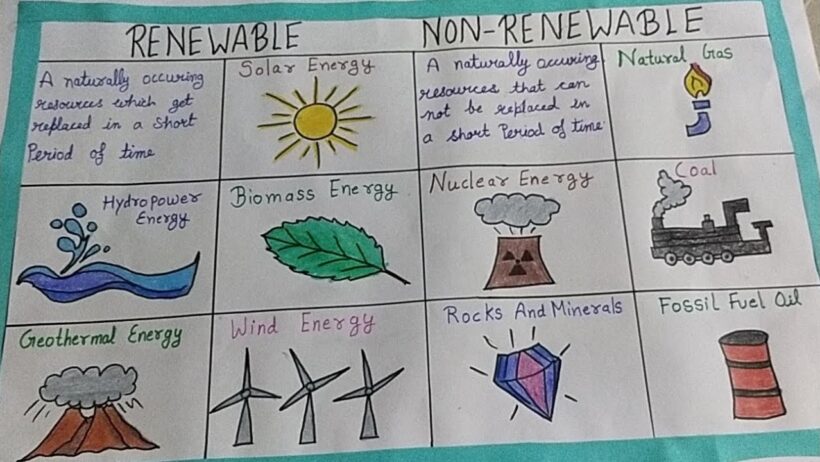In the discussion surrounding climate change, the distinction between renewable and nonrenewable resources plays a pivotal role. This essay delves into the intricate relationship between these types of resources and their respective impacts on global warming, while also emphasizing the necessity of choosing a sustainable path for the future of our planet.
Understanding Renewable Resources
Renewable resources, by definition, are those that can be replenished naturally over time. This category encompasses solar, wind, geothermal, hydroelectric, and biomass energy. The most salient characteristic of these resources is their minimal emissions of greenhouse gases (GHGs) during operation, which is crucial given that GHGs are the primary culprits behind global warming. For instance, solar panels harness the sun’s energy, converting it into electricity without releasing carbon dioxide (CO2) or other harmful pollutants into the atmosphere.
Utilizing renewable resources presents significant opportunities for mitigating climate change. For one, they contribute to a vast reduction in our carbon footprint. As more countries adopt renewable technologies, the reliance on fossil fuels diminishes, leading to a marked decline in emissions. Additionally, renewable resources are inherently sustainable; as they are replenished naturally, they can provide energy without depleting the Earth’s finite reserves. This sustainability is fundamental for future generations.
The Implication of Nonrenewable Resources
In stark contrast, nonrenewable resources, including coal, oil, and natural gas, are finite. Extraction and consumption of these resources lead to substantial emissions of greenhouse gases. The combustion of fossil fuels is responsible for a significant portion of global CO2 emissions, which trap heat in the atmosphere and exacerbate the greenhouse effect. This phenomenon results in rising global temperatures, melting ice caps, and increasingly severe weather patterns.
The adverse effects of nonrenewable resource consumption extend beyond emissions. The extraction processes—such as mining and drilling—contribute to habitat destruction, biodiversity loss, and soil and water pollution. Not only do these activities aggravate climate change, but they also destabilize ecosystems that are vital for maintaining the planet’s health.
The Complex Interplay Between Energy Types
The transition from nonrenewable to renewable resources is not without its challenges. Infrastructure development, political will, and investment are essential to foster a shift toward sustainability. Countries rich in fossil fuel resources may be hesitant to transition away from these economically beneficial energy sources. However, embracing renewable technologies with foresight can yield economic advantages in the long run.
Moreover, the debate around energy consumption is not limited to the type of resources used; it also involves how they are consumed. Energy efficiency plays a significant role in mitigating global warming. For example, while electric vehicles reduce reliance on fossil fuels, if the electricity that powers them is derived from nonrenewable resources, the positive impact on greenhouse gas emissions is diluted. Thus, the entire energy ecosystem must be evaluated to ensure a comprehensive reduction in carbon emissions.
Adopting a Sustainable Path
To address global warming effectively, a multidisciplinary approach is imperative. Governments, corporations, and individuals all have roles to play in facilitating the transition to renewable energy. Policymakers must invest in education and infrastructure that promote renewable energy technologies. Public awareness campaigns regarding energy conservation, carbon emissions, and the importance of sustainable consumption are critical.
Corporations, too, need to adopt sustainable practices by prioritizing green technology in their operations. Concurrently, consumers can make informed choices by opting for products and services that adhere to sustainable practices. Supporting renewable energy initiatives not only contributes to a reduction in GHG emissions but can also influence market dynamics, encouraging more businesses to invest in sustainable practices.
Therefore, communities must embrace initiatives such as local solar energy projects and wind farms, which not only harness renewable energy but also create jobs and invigorate local economies. Sustainability, indeed, is not merely an environmental concern but a socio-economic imperative.
Technological Innovations Driving Change
Innovation plays a crucial role in the renewable energy landscape. Advancements in technology have made renewable resources more efficient and cost-effective. For instance, improvements in energy storage solutions, such as batteries, allow for the storage of solar and wind energy, making it available even when conditions are not favorable for energy generation. Such innovations facilitate a more reliable and robust energy grid, allowing for a smoother transition from nonrenewable to renewable energy sources.
Additionally, the rise of smart grids—integrated systems that optimize energy use—heightens the efficiency of renewable resources. These grids allow for real-time monitoring and management of energy flow, further reducing waste and improving reliability. Through these technological advancements, society can take significant strides toward reversing the climate crisis.
Conclusion
The contrasting impact of renewable and nonrenewable resources on global warming is undeniably significant. While nonrenewable resources perpetuate a cycle of greenhouse gas emissions and environmental degradation, renewable resources offer a beacon of hope for a more sustainable future. By investing in technology, education, and legislative changes, we can pivot toward a greener economy that prioritizes environmental integrity. Ultimately, the choices made today will shape the planet’s climate trajectory for generations to come. Embracing a sustainable path is not merely idealistic; it is imperative for the well-being of both our planet and its inhabitants.






